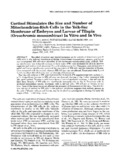Cortisol stimulates the size and number of mitochondrion-rich cells in the yolk-sac membrane of embryos and larvae of tilapia (Oreochromis mossambicus) in vitro and in vivo

View/
Request this document
Date
1995Page views
201Metadata
Show full item recordCited times in Scopus
Share
Abstract
The effect of cortisol and thyroid hormones on the activity of mitochondrion-rich (MR) cells in the yolk-sac membrane of tilapia (Oreochromis mossambicus) embryos and larvae was investigated. MR cells were identified by the fluorescent mitochondrial stain DASPEI. Yolk-sac membranes from 4-day-old embryos in fresh water (FW) were incubated for 24 h in medium supplemented with cortisol, thyroxine (T4), or triiodothyronine (T3). Treatment with cortisol at 0.1 μ/ml and higher significantly increased the population of MR cells and the intensity of fluorescence compared with the control, whereas MR cell size was not affected. Treatments with T4 and T3 did not affect MR cell density, size, or intensity of fluorescence.
Four-day-old embryos in FW were immersed for 10 days in FW supplemented with cortisol, T4, or T3. A significant increase in MR cell size was observed starting on day 3 after treatment with 100 μ/ml cortisol. Treatment with lower doses of cortisol produced increases in the cell size on later days. Density of MR cells was significantly increased only on day 9. Treatment with T4 produced inconsistent results. Treatment with T3 did not affect MR cell size or density at any time. None of the three hormones affected the intensity of fluorescence of MR cells. The stimulatory activity of cortisol on MR cells in the yolk-sac membrane suggests that cortisol, present in the yolk of tilapia embryos and larvae, may be involved in osmoregulation during the early life stages of fish.
Suggested Citation
Ayson, F. G., Kaneko, T., Hasegawa, S., & Hirano, T. (1995). Cortisol stimulates the size and number of mitochondrion-rich cells in the yolk-sac membrane of embryos and larvae of tilapia (Oreochromis mossambicus) in vitro and in vivo. Journal of Experimental Zoology , 272(6), 419-425. https://doi.org/10.1002/jez.1402720603
Subject
Collections
- AQD Journal Articles [1215]

